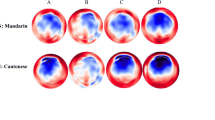Abstract
This study examined the importance of syllable position, duration, and tone/pitch for the assignment of stress in Chinese hums. Twenty native Mandarin speakers and 20 native English speakers were asked to assign primary stress to two-syllable Chinese hums. The importance of acoustic cues for stress assignment was also evaluated. Our findings indicate that syllable position plays the most prominent role in stress assignment. Native Chinese listeners preferred to assign stress to final syllables whereas native English listeners preferred to assign stress to initial syllables. Both language groups were sensitive to different acoustic cues in assigning stress. The effects of complex interactions of syllable position, tone, duration and intensity on stress assignment in Chinese hums for both language groups support the hypothesis that linguistic experience affects speech perception at the suprasegmental level.








Similar content being viewed by others
References
Archibald, J. (1992). Transfer of L1 parameter settings: Some empirical evidence from Polish metrics. Canadian Journal of Linguistics, 37, 301–339.
Archibald, J. (1993). The learnability of English metrical parameters by adult Spanish speakers. International Review of Applied Linguistics and Language Teaching, 31(32), 129–142.
Archibald, J. (1997). The acquisition of English stress by speakers of nonaccentual languages: Lexical storage versus computation of stress. Linguistics, 35, 167–181.
Beckman, M. E. (1986). Stress And Non-Stress Accent. Netherlands Phonetic Archives 7. Dordrecht: Foris.
Boersma, P., & Weenink, D. (2015). Praat: Doing phonetics by computer [Computer program]. Version 6.0.16. Retrieved January 18, 2015 from http://www.praat.org/.
Chao, Y. R. (1979). A Grammar of Spoken Chinese. CA: University of California Press.
Chen, M. Y. (2000). Tone Sandhi patterns across Chinese dialects. Cambridge, UK: Cambridge University Press.
Cutler, A., & Butterfield, S. (1992). Rhythmic cues to speech segmentation: evidence from juncture misperception. Journal of Memory & Language, 31, 218–236.
Cutler, A., & Carter, D. M. (1987). The predominance of strong initial syllables in the English vocabulary. Computer Speech and Language, 2, 133–142.
Cutler, A., & Norris, D. G. (1988). The role of strong syllables in segmentation for lexical access. Journal of Experimental Psychology: Human Perception & Performance, 14, 113–121.
Duanmu, S. (2000). The phonology of standard Chinese. New York: Oxford University Press.
Duanmu, S. (2004a). Tone and non-tone language: An alternative to language typology and parameters. Language and Linguistics, 5(4), 891–924.
Duanmu, S. (2004b). Left-headed feet and phrasal stress in Chinese. Cahiers de Linguistique Asie Orientale, 33(1), 65–103.
Fry, D. B. (1955). Duration and intensity as physical correlates of linguistic stress. Journal of the Acoustical Society of America, 27, 765–768.
Fry, D. B. (1958). Experiments in the perception of stress. Language and Speech, 1, 126–152.
Gandour, J. T. (1983). Tone perception in far Eastern languages. Journal of Phonetics, 11, 149–175.
Hoa, M. (1983). L’Accentuation en Pékinois. Paris: Editions Languages Croisés.
Hyman, L. (1977). On the nature of linguistic stress. In L. Hyman (Ed.), Studies in Stress and Accent. Los Angeles: Department of Linguistics, University of Southern California.
Jongman, A., & Moore, C. (2000). The role of language experience in speaker and rate normalization processes. In: Proceedings of the 6th International conference on spoken Language Processing, I, pp. 62–65.
Jusczyk, P. W., & Aslin, R. N. (1995). Infants’ detection of the sound patterns of words in fluent speech. Cognitive Psychology, 29, 1–23.
Jusczyk, P. W., Houston, D., & Newsome, M. (1999). The beginnings of word segmentation in English learning infants. Cognitive Psychology, 39, 159–207.
Kochanski, G., Shih, C., & Jing, H. (2003). Quantitative measurement of prosodic strength in Mandarin. Speech Communication, 41, 625–645.
Lehiste, I. (1970). Suprasegmentals. Cambridge, MA: MIT Press.
Lehiste, I., & Fox, R. A. (1992). Perception of prominence by Estonia and English listeners. Language and Speech, 35, 419–434.
Lin, M., Yan, Z., & Sun, G. (1984). A preliminary experimental study on normal stress of disyllabic words in Chinese. Dialects, 1, 57–73.
Pierrehumbert, J. (1980). The phonology and phonetics of English intonation. Doctoral dissertation, MIT.
Selkirk, E., & Shen, T. (1990). Prosodic domains in Shanghai Chinese. In S. Inkelas & D. Zec (Eds.), The Phonology-Syntax Connection. Stanford: CSLI Stanford Univeristy. Distributed by University of Chicago Press.
Thiessen, E. D., & Saffran, J. R. (2003). When cues collide: Use of stress and statistical cues to word boundaries by 7—to 9-month-old infants. Developmental Psychology, 39, 706–716.
Wang, J., & Wang, L. (1993). Putonghua duo yinjie ci yinjie shi chang fenbu moshi [The types of relative lengths of syllables in polysyllabic words in Putonghua]. Zhongguo Yuwen (Beijing), 2, 112–116.
Wang, Y. J., Chu, M., Lin, H., & Feng, Y. (2003). Stress perception of Chinese disyllabic words in utterance. Chinese Journal of acoustics, 22, 86–96.
Wayland, R., Guion, S. G., & Landfair, B. L. (2006). Native Thai speakers’ acquisition of English word stress patterns. Journal of Psycholinguist Research, 35, 285–304.
White, C. M. (1981). Tonal perception errors and interference from English intonation. Journal of Chinese Language Teacher Association, 16, 27–56.
Xu, I., Chu, M., He, L., Lu, S., & Guan, D. (2000). The influence of Chinese sentence stress on pitch and duration. Chinese Journal of acoustics, 19, 270–276.
Yan, J., & Lin, M. (1988). Acoustic characteristics of the stress in Beijing trisyllables. Fangyan, 3, 227–237.
Yu, V. Y., & Andruski, J. E. (2010). A cross-language study of perception of lexical stress in English. Journal of Psycholinguistic Research, 39, 323–344.
Author information
Authors and Affiliations
Corresponding author
Ethics declarations
Conflict of interest
The authors declare that they have no conflict of interest.
Ethical Approval
All procedures performed in the study involving human participants were in accordance with the ethical standards of the institutional research committee. The study received ethical approval from the Institutional Research Ethics Board, California State University Northridge. Informed consent was obtained from all individual participants included in the study.
Additional information
Publisher's Note
Springer Nature remains neutral with regard to jurisdictional claims in published maps and institutional affiliations.
Rights and permissions
About this article
Cite this article
Yu, V.Y. Effects of Syllable Position, Fundamental Frequency, Duration and Amplitude on Word Stress in Mandarin Chinese. J Psycholinguist Res 50, 293–312 (2021). https://doi.org/10.1007/s10936-020-09731-6
Published:
Issue Date:
DOI: https://doi.org/10.1007/s10936-020-09731-6




